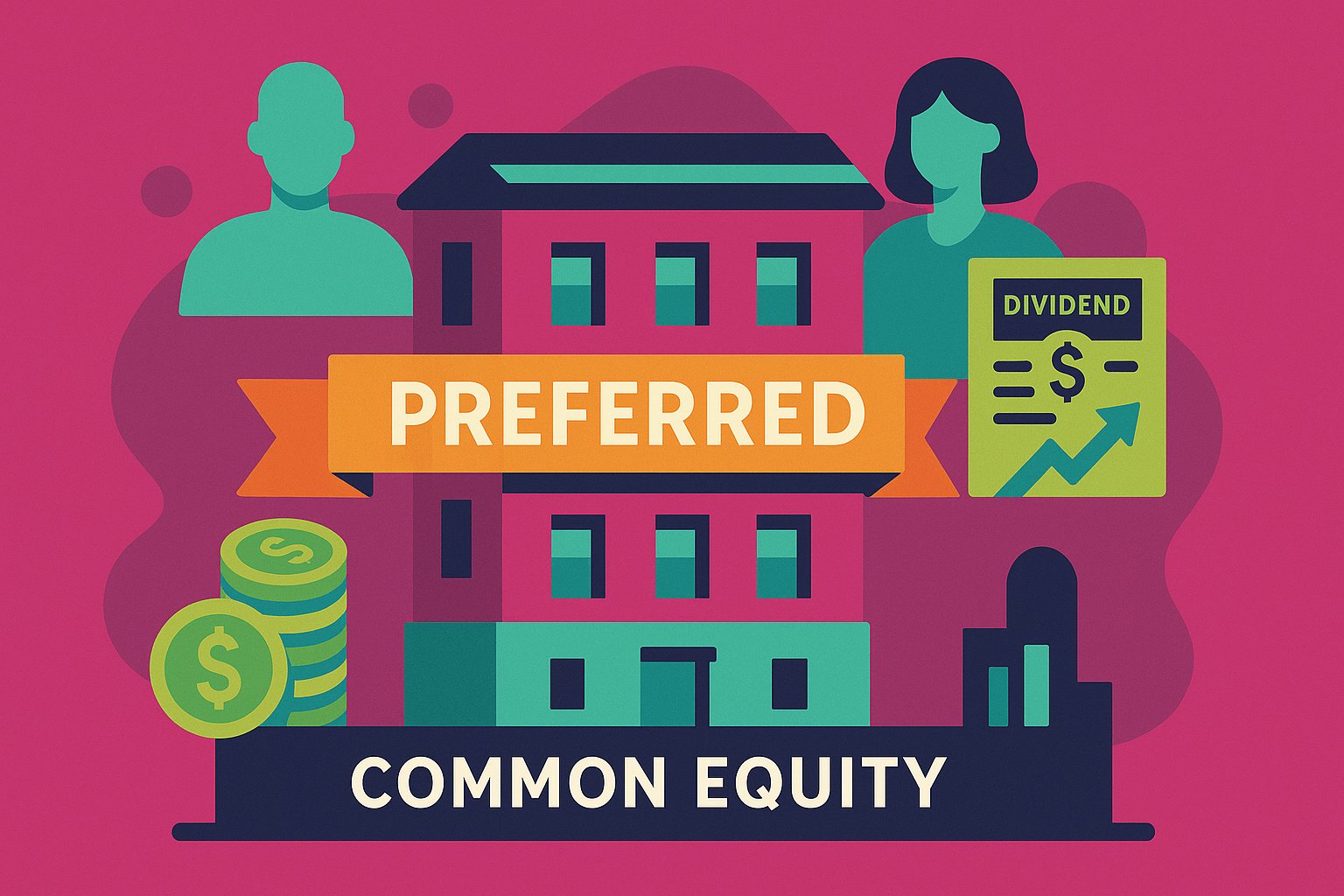The Rise of Preferred Equity in Crowdfunding Landscapes
In recent years, real estate crowdfunding has opened doors that were once reserved for institutional giants and high-net-worth individuals. As platforms evolve, so do the types of capital structures available to investors. Among these structures, preferred equity has emerged as a compelling middle ground—offering more upside than debt instruments while imposing fewer risks than common equity. For anyone exploring real estate crowdfunding deals, understanding preferred equity is pivotal. In this article, we’ll dive into the essence of preferred equity, examine how it fits within the capital stack, explore its benefits and drawbacks, and offer practical guidance for evaluating preferred equity offerings. Whether you’re a novice investor or a seasoned pro, mastering the nuances of preferred equity can unlock new pathways to balanced returns and enhanced portfolio diversification.
Decoding Preferred Equity: A Unique Capital Position
Preferred equity sits between senior debt and common equity in a project’s capital stack, effectively bridging the gap between lenders and true owners. Unlike senior debt—where lenders receive fixed interest payments and have a first claim on assets—preferred equity investors receive a predetermined “preferred return” before common equity participants see distributions. However, they do not enjoy the full upside potential that common equity holders capture when a property is sold at a premium. In most crowdfunding deals, preferred equity is structured to provide investors with a fixed annual return, often ranging between 6 and 12 percent, depending on the project’s risk profile and location.
Because preferred equity does not carry the same repayment priority as senior loans, it typically bears higher returns than debt. Yet, unlike common equity, which fluctuates with market conditions and can drop to zero in a distressed scenario, preferred equity often has contractual safeguards—such as cumulative dividends or liquidation preferences—that protect investors’ capital. By occupying this mid-tier position, preferred equity strikes a balanced risk-return profile, making it an attractive option for those seeking steady income without the heightened volatility of pure equity holdings.
The Mechanics of Preferred Returns and Waterfall Structures
At the heart of every preferred equity deal lies the concept of the preferred return—a fixed percentage that preferred investors expect before any residual profits flow to common equity. Suppose you participate in a crowdfunding project offering a 10 percent preferred return. If you invest $50,000, you can anticipate $5,000 in annual returns, paid quarterly or annually, depending on the sponsor’s structure. Payments continue as long as the project meets minimum cash flow requirements; if cash flow dips, some structures defer preferred dividends until cash becomes available.
Crucial to understanding preferred equity is the waterfall distribution structure. Imagine a project that generates $1 million in distributable cash during a given period. First, senior lenders receive their contractual debt service—interest and principal—say, $500,000. Next, preferred equity investors collect their cumulative preferred return—let’s assume $300,000. Once these obligations are met, any remaining cash—$200,000 in this example—flows to common equity participants. In a sale scenario, proceeds follow a similar hierarchy: senior debt is repaid first, followed by the return of preferred equity capital and any accrued dividends. Only after these tiers are satisfied do common equity holders share in the remaining profits. This sequence underscores the asymmetric risk profile of preferred equity: investors enjoy higher priority than common equity but must recognize that their upside is usually capped at the preferred return plus perhaps a negotiated “participation” feature if the deal includes a share of surplus profits.
Evaluating Risk and Reward in Preferred Equity Positions
Preferred equity’s unique value proposition lies in offering a blend of risk mitigation and upside. On the risk side, preferred equity is subordinated to senior debt, meaning that if a project underperforms—due to lower occupancy, unexpected repairs, or market headwinds—preferred investors may experience deferred payments or, in extreme cases, partial loss of capital. Although some preferred instruments include cumulative features—where unpaid dividends accumulate until cash flow resumes—there is no guarantee that a distressed property will generate enough proceeds at sale to cover all accrued returns. Investors must therefore conduct thorough due diligence on property fundamentals, market dynamics, and sponsor track records to assess the likelihood of timely and full preferred return payments.
Conversely, preferred equity often provides more attractive returns than senior loans. If a debt instrument yields 5 percent annually but a comparable preferred equity offering promises 9 percent, investors willing to stomach the additional risk may find the potential reward compelling. Some preferred structures include a “participating feature,” granting preferred investors a percentage of residual sale proceeds after they receive their capital back and any accrued preferred returns. This hybrid returns structure can elevate total upside, bridging the gap between static debt and full equity exposure. However, investors should closely examine the cap on participation and the multiple clauses—such as “2x return hurdles”—that dictate when participation kicks in. Without these details, preferred investors may miss out on meaningful profits if the deal performs exceptionally well.
How to Identify High-Quality Preferred Equity Offerings
Not all preferred equity opportunities are created equal. While high preferred returns can be enticing, deals boasting double-digit preferred rates often signal elevated risk—whether due to location uncertainty, unproven sponsors, or aggressive underwriting assumptions. To identify high-quality opportunities, start by evaluating the sponsor’s track record. Sponsors with histories of successful project execution—on time and on budget—tend to underwrite deals conservatively, preserving preferred return stability. Scrutinize past deals: examine whether commercial properties reached targeted occupancy levels, how the sponsor handled capital cost overruns, and whether distributions consistently met preferred return schedules. A strong sponsor biography should include verifiable metrics, such as historical IRRs on similar projects and verified capital raises, which lend confidence to the current offering.
Next, consider market fundamentals. A preferred equity deal targeting a multifamily property in a city with rising rental demand, constrained new supply, and an expanding job market offers a sturdier foundation than a similar property in a stagnant or declining area. Compare comparable properties—occupancy trends, rental growth rates, and cap rates—to gauge whether projected cash flows are realistic. Additionally, review loan-to-value (LTV) and debt-service coverage ratio (DSCR) metrics, even for preferred equity. Although senior debt holds first lien position, a conservative LTV—typically below 65 percent—and a DSCR above 1.25x indicate that debt servicing is manageable and cash flows available to preferred investors are more secure.
Finally, delve into exit assumptions. If a preferred equity offering hinges on an exit in two years predicated on significant asset appreciation, ensure the sponsor’s market analysis supports such assumptions. A realistic exit timeline—five to seven years for value-add properties—aligns with typical renovation and lease-up cycles. Overly optimistic timelines can jeopardize preferred return payments if refinancing or disposition occurs prematurely. By combining sponsor vetting, market research, and careful review of underwriting assumptions, you can better separate robust preferred equity deals from overly optimistic or risky propositions.
Comparing Preferred Equity to Other Hybrid Capital Options
In real estate crowdfunding, hybrid structures frequently blur lines between traditional debt and preferred equity. Subordinated debt (“mezzanine debt”) often resembles preferred equity, offering fixed interest rates above senior loans but below pure equity returns. Key differences emerge in covenants and enforcement. Mezzanine debt typically includes lender protections—such as the right to step in and manage the property if the borrower defaults—whereas preferred equity investors often rely on contractually defined “liquidation preferences” without direct enforcement rights. Preferred equity can afford investors more flexibility, as it usually lacks trigger events that automatically push the sponsor into default upon minor covenant breaches. However, this flexibility can cut both ways: a sponsor could temporarily defer preferred dividends to preserve cash flow, whereas a mezzanine lender might seize ownership under a default, protecting capital but cutting off upside.
Convertible preferred equity represents another variant. In this structure, preferred investors initially receive a fixed preferred return, but if the property exceeds specified performance thresholds— such as a 15 percent IRR—the preferred position converts to common equity at prearranged terms. This conversion feature maximizes upside potential but requires detailed scrutiny of conversion ratios, timing windows, and any thresholds that must be met. Investors should weigh whether the additional complexity and possible dilution make convertible structures more or less appealing than straight preferred equity or mezzanine debt.
By comparing these hybrid options side by side, investors can tailor their allocation to align risk tolerance and return objectives. Conservative investors may gravitate toward simple, fixed-preferred returns with protective covenants, while growth-oriented investors might opt for convertible preferred structures that offer a pathway to equity—albeit with a more contingent, performance-based approach.
Timing and Liquidity Considerations in Preferred Equity Investments
A common question among crowdfunding participants is: “How long will my capital be tied up?” Preferred equity deals typically carry longer-than-senior debt hold periods—often five to eight years—because sponsors need time to stabilize properties, execute value-add strategies, and wait for market conditions to optimize exit opportunities. While senior debt may amortize over a decade with scheduled principal repayments, preferred equity remains outstanding until a refinancing or sale event occurs. During this period, investors receive quarterly or annual preferred return payments, but they generally cannot redeem their shares early unless the platform offers a secondary market. Even then, secondary trading in preferred equity often involves wide bid-ask spreads and irregular buyer demand, potentially locking investors into longer holding horizons.
Understanding these timing constraints is critical for managing cash flow expectations. If you anticipate needing the capital within three years, preferred equity may not suit your liquidity needs. That said, some platforms bundle preferred equity investments into interval funds—structures that permit quarterly redemption windows at net asset value. While these funds enhance liquidity, they also impose redemption gates if more than a certain percentage of investors request withdrawals. Therefore, balance your desire for preferred returns with personal liquidity preferences. If you value potential early exit pathways, explore offerings that provide both preferred return features and transparent secondary market channels, or consider interval funds with predictable redemption schedules.
Navigating Tax Implications and Reporting Requirements
Preferred equity distributions often blend return of capital, dividend-like payments, and occasional capital appreciation through participation features. From a tax perspective, these components can carry different treatment. Interest-equivalent payments on preferred equity are frequently classified as ordinary income, taxed at your marginal rate. Return of capital distributions reduce your cost basis in the preferred equity position, deferring tax liability until you sell your position or receive a liquidation preference. Participation or gain from an exit event may be taxed as capital gains—either short-term or long-term, depending on how long you held the investment.
Because preferred equity offerings usually involve private placements, investors often receive K-1 forms reflecting partnership income, distributions, and depreciation deductions if the sponsor’s structure passes through tax benefits. K-1s can be complex and may arrive later in the tax season than standard 1099-DIV or 1099-INT forms. To navigate these intricacies, collaborate with a tax advisor experienced in real estate investments. They can help you optimize your after-tax returns by leveraging depreciation, analyzing qualified business income (QBI) deductions, and planning for potential state-specific taxes. Staying informed about the tax treatment of preferred equity ensures that the net returns you anticipate align with your financial projections.
Building a Preferred Equity Investment Strategy
Armed with an understanding of preferred equity mechanics, risks, and tax nuances, it’s time to craft a strategy that fits your goals. Start by setting clear return targets: do you seek a steady 8 percent annual yield, or is 6 percent acceptable in exchange for better downside protection? Align your preferred equity selections with market conditions: in high-interest-rate environments, preferred yields may rise to compensate investors, but higher rates can also compress property valuations, affecting exit timing. During economic expansions, aggressive preferred equity offerings might target transitional assets—like value-add multifamily properties—where sponsors assume risk to renovate and re-lease units. Balancing your allocation between core-fund-like preferred equity in stabilized markets and opportunistic preferred equity in growth markets can optimize risk-adjusted returns.
Next, monitor your portfolio’s diversification. Preferred equity investments often cluster around specific asset types—multifamily, industrial warehouses, or retail centers—depending on platform expertise. If all your preferred positions reside in a single sector, like hospitality, you become vulnerable to that sector’s downturns. Instead, spread capital across different property types and geographic regions to buffer against localized headwinds. Regularly review quarterly reports to track performance metrics—occupancy rates, net operating income, and debt service coverage ratios—so you can detect early warning signs of underperformance. By staying engaged with sponsor updates and market research, you’ll be better positioned to reallocate capital, participate in new preferred offerings that complement existing positions, and avoid overconcentration in any one niche.
Embracing the Future of Preferred Equity in Crowdfunding
As real estate crowdfunding continues to mature, preferred equity’s role within the capital stack is only set to expand. Savvy sponsors recognize that hybrid structures resonate with a wide spectrum of investors—those seeking stable yields and those thirsting for selective equity upside. Meanwhile, platforms are developing more sophisticated tools, such as interactive dashboards that allow preferred equity investors to simulate distributions under multiple scenarios or digital forums to discuss preferred equity deal performance with other participants. In this evolving environment, early adopters of preferred equity strategies will accumulate a deeper understanding of how to balance yields, manage risks, and integrate tax benefits into their broader portfolios.
Ultimately, preferred equity in real estate crowdfunding deals offers a middle path—one that blends predictability with growth potential. By carefully evaluating sponsor track records, market fundamentals, and distribution structures, you can build a resilient portfolio that leverages preferred equity’s unique strengths. As you gain experience, layering preferred equity positions alongside senior debt notes and selective common equity stakes can create a finely tuned capital stack—one that navigates market cycles with greater confidence and maximizes returns over the long haul. So as you plan your next crowdfunding venture, consider the power of preferred equity: it may be the keystone that transforms your real estate aspirations into sustainable, income-generating reality.




